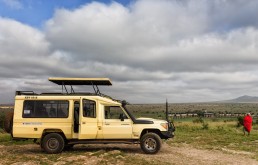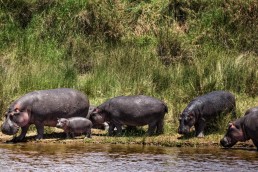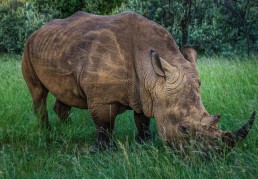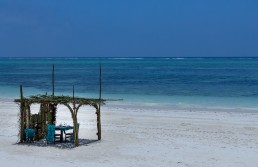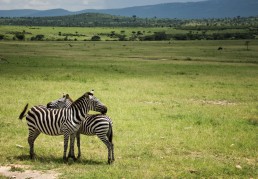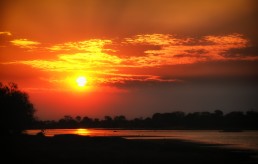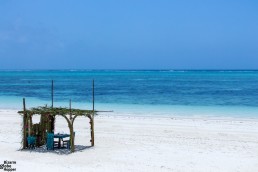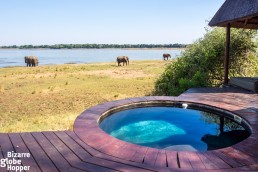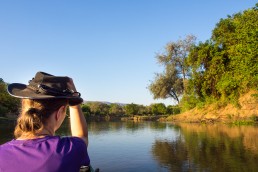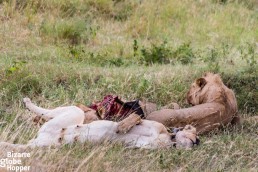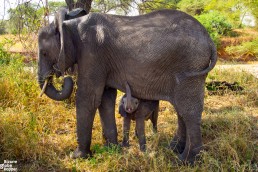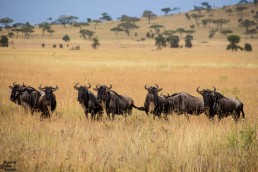Wondering what to pack for African safari? It can be a daunting task if you don’t even know where to start. Don’t dither – we’re here to help you out with our ultimate African safari packing list and in-depth guide.
Most of the times it’ll be hot, so think about lightweight and breathable clothing, and excellent sun protection. African landscapes are also dusty, which is why people prefer neutral colors. You know, dust wears better in neutral colors than vibrant tones.
Also, the classic bush colors, like the khaki and military green help you to blend in the environment while on a walking safari, sitting in a game drive vehicle, or other activities outside the car. Then again, temperatures can drop at night, so a good sweater or a jacket is essential to keep you warm.
The most critical rule-of-thumb is: keep it simple and light! Otherwise, you’ll have problems with the micro aircraft to remote destinations where they have strict weight limits for luggage. And if you lack something of importance, you can probably buy it when you’re in Africa. Just do your shopping when you’re in the bigger cities, and you’re going to be well equipped.
Now, everybody knows that the devil is in the details, so let’s get into it!
*This post contains affiliate links. If you use them, there won’t be any additional costs for you, but we may receive a small commission, which helps us keep up this blog.
Best Safari Clothing
Practicality and comfort should come first when you are packing your safari wear. Fashionable and colorful prints aren’t going to impress anyone, but being neutral will help you get closer to the animals.
Think about these principles when you’re packing for your safari outfit:
• Comfortable clothes for long journeys on safari vehicles
• Lightweight, breathable fabrics and neutral colors
• Long sleeves (for arms and legs) to prevent sunburn and protect the skin from insects
• Something warm for the evenings and early mornings
What exact clothes to pack will vary depending on your destinations and the time of year you are traveling. But what is consistent across most of Africa, is the intensity of the sun. One of the most essential pieces of garment to fight the scorching sun is an excellent safari hat!
If you’re traveling on the rainy season, consider taking a right, lightweight rain gear. The rains during this season are generally of the thunderous kind, pouring down torrentially for an hour or two before the skies will clear again. However, if you’re in the open ground, these moments can leave you thoroughly drenched, if you’re not prepared – and sometimes even if you are. But a great Gore-Tex jacket like this will save you from the worst.
And when you go on the early morning game drives before the sun rises, it will be a bit chilly – just as it may be in the evenings. Be prepared with a piece of warmer clothing, too, like a warm jacket or a fleece.
Why Neutral Colors Are Recommended for an African Safari Clothing
You may immediately think of the “classic” safari tourist look; someone dressed from head to toe in matching khaki safari outfit, like straight out of a movie. You can do that, too, but just remember that is isn’t a fashion show and whatever you wear, think practicality first.
There are three good reasons for the monotone colors. On game drives, the animals don’t see you, they see the safari vehicle. The 4x4s are usually a dull green or soft khaki, which helps them seem less threatening. So, it doesn’t matter so much what you are wearing, but it’s always better if you can blend in with the car. Also, it isn’t advisable to wear bright, flashy colors even on game drives, especially not blue.
But when you are going on a walking safari or a horse riding safari, it’s a whole another story. Then you will be entering the wild animals’ kingdom, and when you’re on foot or on horseback, they will see you. Bright colors will stand out, and that alerts animals to your presence and can potentially be even dangerous, especially when encountering the larger animals. This is why you should always wear neutral colors on these occasions and blend into the landscape. It’s safer and being discreet is going to help you get closer to the animals.
Most safari landscapes are also very dusty, especially in the long dry season and you can’t avoid getting the dust everywhere, and dust wears better on neutral colors.
What Do You Wear on the Evenings?
Basically, anything you’d like and anything you have brought in your lightweight luggage. Evenings are enchanting times, as you’ll probably have dinner outside on a deck or a balcony while listening to the sounds of the wildlife and watching the fantastic blanket of stars above.
Even on the most luxurious lodges, there are not any policies on what to wear. You are still on a safari, remember. After the days’ activities and dusty game drive, you will want to have a shower and change clean clothes for the evening, though.
You can wear a bit more relaxed or even a bit fancier clothes if you want to, but don’t overdo it – this is the wilderness, not the Ritz. Pack for comfort and remember that in the evenings the temperatures will drop significantly and it’s the prime time for the mosquitoes, too.
What to Wear at the Beaches in Africa?
Swimsuits are generally okay and acceptable on the beaches, but nudity is not. Also, it’s not usually ok to walk around villages and beachside towns in swimwear, especially in Zanzibar and along the Kenyan coast. However, sarongs are fashionable, and you can pick one up from almost anywhere around the coastal areas. There is a beautiful selection of bright colors and patterns available.
Best Safari Shoes
Comfortable, closed footwear is the one to take with you. Aim for the most comfortable, yet a lightweight shoe for here, too. Sneakers, runners, gym shoes, etc. are all adequate for game drives, if that is all you are doing.
If you’re also doing a walking safari, then a bit stronger footwear is recommended, and then we’re talking about the bulkier hiking boots. The terrain is unforgiving and harsh, filled with rocks, spikes, roots and everything in between. Also, many tiny insects are buzzing around the ankle level, and you can get bitten if much skin is exposed.
However, if walking is not a primary part of your itinerary, you can entirely get by with lighter, yet sturdy and comfortable boots. But if you’re doing a lot of walking, be prepared with the sturdy, but heavier hiking boots.
We have been on several safaris and what we usually bring is our trusted and brilliant HAIX Black Eagle Athletic mid 10 Desert boots – they have it all: waterproof Gore-Tex, lightweight, the most comfortable ever (on long day’s hikes, too!), heavy-duty made by military standards. These shoes are very hard to beat as superb travel shoes!
Best Safari Travel Bags
The best bags to take are backpacks, not those bulky and big, hardshell luggage. Those hardshell travel cases take too much space, and you may not even be allowed to take them to the smaller bush aircraft where space is insufficient.
We have always used our 65L backpacks, and when packed moderately to keep it as lightweight as possible, we have been fine.
As a general backpack for a daypack, the best one I’ve used so far is the 22L Hazard4 Second Front Backpack (as Coyote Brown, though). It has a great, separate hydration/laptop back-pocket (fits even most 17” laptops), unbeatable expansion options with MOLLE webbings all around the pack and its usability is top-notch. The Coyote Brown color is also perfect for the dusty African landscapes because the dust won’t ever show on it!
Made out of the extra tough, 1000D Cordura fabric, it’ll take more beating than you can imagine and still come out just fine. The material is also pretty water resistant, but I always recommend a separate rain cover. Military grade quality will guarantee that this pack will hold on with your every adventure!
Good shoes are vitally important, no matter how long your safari will be. From only a 3-days Kruger safari in South Africa to over two weeks off-the-grid in the thickest bush.
What Gadgets and Electronic Devices to Pack on an African Safari?
Take the necessities you will need. Remember to pack the chargers of your laptop, camera, eReader, tablet and take the adapter, as the electric socket is probably different from the ones in your country.
*A reading tip: If you have your eReader with you, my top recommendation for you to read would be “The Obstacle Is The Way” by Ryan Holiday!
Apparently, the camera is the most important for a lot of us on an African safari. What kind of camera to take, what lenses, etc. depends on how serious a photographer you are.
If you are like me, who takes her photography to professional levels, you will at least pack your camera body/bodies, one prime lens, one zoom lens, and one telephoto lens. Good tripod, spare batteries, several memory cards, and external hard drive are also must-items to accompany your laptop with your favorite photo editing software (like Lightroom and Photoshop).
A good photography backpack that fits you perfectly is also essential and I’ve recently found that my new Shimoda Explore 40 photography backpack is just superb! It’s the best photography backpack I’ve ever owned and I expect to carry it with me for many years to come on every adventure ahead.
I just made my change from the DSLR to the mirrorless system and bought my first ever Sony camera body!
In my photography backpack, there is now a Sony A7RIII and a Metabones V adapter, because I still have these Canon lenses: EF 24-105mm f/4L IS USM, EF 70-300mm f/4-5.6L IS USM, EF 50mm f/1.8 STM. With this set, I can get a vast variety of shots, though if I could change something, I would take more lens reach, preferably up to the 600mm (I’m working on that).
For audio recording, I have the Zoom H2n recorder, and for my camera I have a lightweight Rode VMGO video mic. A GoPro is something you won’t necessarily need on an African safari, but I’ve used it, for example, to record some time lapses of the fantastic African starry skies and sunsets/sunrises. We have the Hero4 Silver model which is great with the rear display.
Always a good idea to pack on an African safari is some spare AA and AAA batteries, as these may not be readily available, especially when you are out in the bush.
Don’t Forget Your Headlamp or Flashlight – Your African Safari Savior
And the last, but certainly not the least, is a small flashlight or a headlamp! Believe me, you will need it during the pretty regular power cuts that are common in Africa. Some smaller lodges and bush camps also may not have a generator running all night for power so the electricity may not work for certain times of the day. For example, the power may be cut at 10 pm in the evening and then resume at 6 am. With your own, reliable light source you won’t be left in the dark.
We have relied upon the Maglite PRO+ Mini flashlight and the Black Diamond Storm headlamp. Both are absolutely amazing and will give you enough light to do practically anything.
Toiletries and First Aid Kits to Add to Your African Safari Packing List
Every lodge and camp will have at least a basic First Aid kit on hand, but it’s still a good idea to have your own, small supply of the most needed health and hygiene essentials.
Make sure to include at least the following in your own First Aid Kit:
• Antiseptic gel and/or cream
• Antibiotics
• Antihistamines (for bug bites and allergic reactions)
• Painkillers (aspirin, ibuprofen, etc.)
• Band-aids
• Diarrhea medication
• Cold and flu medication (just in case)
• Any prescription medicines you take
• Small scissors
• Antiseptic wipes
• Safety pins
• Coal tablets (if you have them)
Then do not forget mosquito repellant (the most effective ones have at least 30% of DEET), sunscreen (preferable SPF 50+), and malaria pills (if needed).
What you’d like to take as your personal toiletries, is a matter of choice. A travel-sized shampoo, conditioner, deodorant, moisturizers, toothbrush, toothpaste, and some sanitary products (for us ladies) are some of what you will want to take.
Pack For a Purpose
Nowadays many lodges and safari camps support their local community initiatives in and around the National Parks, reserves, and conservation areas. And if you’d want to make a positive difference during your time in Africa, you can check out if you can bring any supplies that will help these local projects. Most of the times they are, for example, medications, clothing, school supplies, etc.
Check out Pack For Purpose for lists of specific projects and requests from lodges and safari companies around Africa, and you can check out the best packing suggestions for the items, too.
If you think that we missed something critical on this ultimate safari packing list, then just tell us in the comments, and we can make some add-ons if needed!
And if you’d want, here you can check out a more item specific post about what gear and gadgets we’ve been packing on our African safaris.
But there you have it, the ultimate African safari packing list!
PIN THIS STORY!
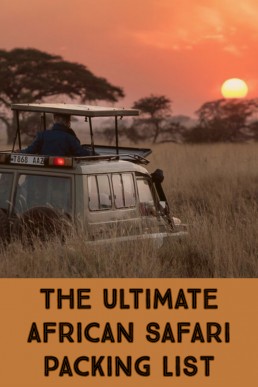
You May Also Like to Read:
10 Romantic Destinations in East Africa
Arouse your wanderlust with our list of 10 romantic destinations in East Africa!
Best Safari Lodges in Zambia – Our Top 4 Picks
Which are the traits behind the best safari lodges in Zambia? Optimize wildlife watching opportunities, find the best guides and delight in lavish camps – smell out the hidden gems of Zambia!
Canoe Safari on the Scenic Zambezi River, Zambia
Float silently through a shallow channel in Lower Zambezi National Park, witnessing baboons solving their household issues on the banks, elephants trumpeting, and hippos splashing all around you.
How to Pack on an African Safari?
Safari coming up and you don’t know what to pack? We’ve been there and created this safari packing list to help you out and avoid the mistakes.
How to Plan the Best Safari in Tanzania
How to plan the best safari itinerary in Tanzania? What are the pros and cons of the high and low season? Check our safari planning tips before you go!
How to Choose a Safari Company in Tanzania: A Comprehensive Checklist
Safari in Tanzania should be the trip of a lifetime. Choose your safari company wisely to get the best out of the gorgeous national parks!


